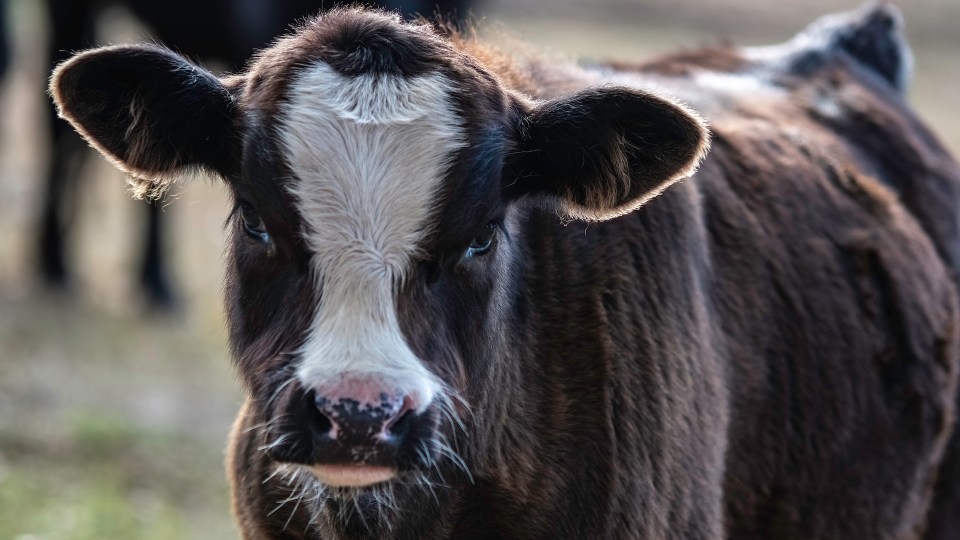How to maximize the quality
and value of beef x dairy calves
By Dr. Chris Schneider
Beef x dairy crossbreeding is still a relatively new concept for many dairy producers and calf raisers, but the trend has continuously grown over the last five-plus years – and it looks like it’s here to stay.
As an industry, we know there’s a lot of opportunity to add value to an operation by using beef sires to breed a portion of their dairy females. Now is the time for dairies to shift their focus to understanding how to best manage and raise the resulting crossbred calves for the best return in the beef market.
To optimize the value from a beef x dairy program, evaluate your management practices and protocols for opportunities to drive calf health and growth. Be aware of the special needs of crossbred calves and adjust management accordingly.

Match nutrition to growth rates
Unlike purely dairy animals that are bred for milk production, crossbred calves sired by beef bulls are genetically built for growth. It’s important to provide them with the appropriate amount and level of nutrition to match their growth potential. For instance, if you normally provide 2-quart bottles of milk for dairy calves, consider providing larger 3-quart bottles for crossbred calves.
However, as with dairy calves, don’t overfeed crossbreds or feed dry feed too soon. Their rumen and digestive systems are built to digest milk, and it takes a while for them to be adapted to feed. Carefully transition to dry feed so calves don’t develop gastrointestinal issues, which are hard to overcome and could affect calves’ health for the rest of their lives.
In general, follow best practices that you would for feeding any cattle: meet or exceed nutrient requirements of calves based on size, gender and desired growth rate,1 consistent feeding times and amounts, quality rations, bunk management, monitor for acidosis, and always provide fresh water and feed.
Look closely at calf nutrition in the first 60 days of life to ensure that it’s balanced for the growth that you’re expecting in these animals and watch feed intake so that their growth rates match. If you’re exhibiting excessive health issues or are unsure about crossbred calves’ feeding needs, work with your nutritionists and veterinarians to evaluate your program.
Optimize immunity against respiratory disease
A major challenge that the industry is experiencing with beef on dairy calves is excessive respiratory disease rates, typically at three to four months of age when calves are weaned out of calf hutches and move to group housing.
To successfully immunize these calves and prepare them for the post-weaning challenges that are coming, use an intranasal vaccine in the first week of life. Depending on your operation and disease challenges, you may want to consider repeating the vaccine at 30 to 60 days of age.
Intranasal vaccines like BOVILIS® NASALGEN® 3 and BOVILIS® NASALGEN® 3-PMH protect against the common pathogens associated with bovine respiratory disease (BRD) without being affected by maternal antibodies.2
At the appropriate time based on label directions, vaccinate for respiratory disease with an approved injectable, such as BOVILIS® VISTA® 5 SQ or BOVILIS® VISTA® ONCE SQ.
Treat BRD diligently
Early intervention is the best tool to successfully control BRD. Train workers to recognize the signs and symptoms of BRD so they know what to do and when to do it, enabling faster identification.
Work with your veterinarian to set disease thresholds for initiating metaphylaxis if disease treatment rates in a group exceed a team established percentage in a length of time. In an outbreak, only treating animals as they are recognized ill may result in delayed treatment, less treatment success and longer disease periods.
Merck Animal Health provides proven solutions for treatment and control of respiratory disease, with cost-effective options based on the stage of the disease.
- AROVYN™ (tulathromycin injection), ZUPREVO® (tildipirosin) and NUFLOR® INJECTABLE SOLUTION (florfenicol) are trusted and proven antibiotics that treat and control respiratory disease.
- RESFLOR GOLD® (Florfenicol and Flunixin Meglumine) combines the powerful dual-therapy of an effective antibiotic with a fast-acting non-steroidal anti-inflammatory drug (NSAID) for first-line treatment results in just one dose.
Work with your veterinarian to establish treatment protocols that include recommended post-treatment intervals.
Continuous improvement
Crossbreeding beef on dairy animals is a practice that is likely here to stay, and the outlook is more positive than ever. Raising crossbred calves is still new to many producers, so it’s important to continuously monitor your success and improve on your program.
Dairies have the opportunity to add more value to beef x dairy calves through health and management practices that emphasize proper nutrition and immune function. Work closely with your veterinarian, nutritionist, university extension specialists and animal health representatives to evaluate your management program and get the greatest return on your crossbred calves.
Contact your Merck Animal Health representative or visit MAHcattle.com to learn more.
Important Safety Information
Arovyn™: AROVYN has a pre-slaughter withdrawal time of 18 days in cattle. Do not use in female dairy cattle 20 months of age or older. Do not use in animals known to be hypersensitive to the product.
ZUPREVO™ 18%: FOR USE IN ANIMALS ONLY. NOT FOR HUMAN USE. KEEP OUT OF REACH OF CHILDREN. TO AVOID ACCIDENTAL INJECTION, DO NOT USE IN AUTOMATICALLY POWERED SYRINGES WHICH HAVE NO ADDITIONAL PROTECTION SYSTEM. IN CASE OF HUMAN INJECTION, SEEK MEDICAL ADVICE IMMEDIATELY AND SHOW THE PACKAGE INSERT OR LABEL TO THE PHYSICIAN. RESIDUE WARNING: Cattle intended for human consumption must not be slaughtered within 21 days of the last treatment. Do not use in female dairy cattle 20 months of age or older. Use of this drug product in these cattle may cause milk residue. A withdrawal period has not been established in pre-ruminating calves. Do not use in calves to be processed for veal. The effects of ZUPREVO® 18% on bovine reproductive performance, pregnancy and lactation have not been determined. Swelling and inflammation, which may be severe, may be seen at the injection site after administration. Subcutaneous injection may result in local tissue reactions which persist beyond slaughter withdrawal period. This may result in trim loss of edible tissue at slaughter. DO NOT USE ZUPREVO® 18% IN SWINE. FATAL ADVERSE EVENTS HAVE BEEN REPORTED FOLLOWING THE USE OF TILDIPIROSIN IN SWINE. NOT FOR USE IN CHICKENS OR TURKEYS.
Nuflor®: Do not use in animals that have shown hypersensitivity to florfenicol or animals intended for breeding purposes. Transient inappetence, diarrhea, decreased water consumption, injection site swelling, anaphylaxis and collapse have been associated with the use of florfenicol in cattle. Do not use in calves to be processed for veal or in female dairy cattle 20 months of age or older, including dry dairy cows. Use in these cattle may cause drug residues in milk and/or in calves born to these cows. Animals intended for human consumption must not be slaughtered within 28 days of the last intramuscular treatment or 38 days of subcutaneous treatment. A withdrawal period has not been established in preruminating calves. Avoid direct contact with skin, eyes, and clothing. Pregnant women should wear gloves and exercise caution or avoid handling this product. For complete information, see the product package insert.
Resflor GOLD®: Not for use in humans. Keep out of reach of children. Do not use in animals that have shown hypersensitivity to florfenicol or flunixin. Avoid direct contact with skin, eyes and clothing as product contains materials that can be irritating. Animals intended for human consumption must not be slaughtered within 38 days treatment. This product is not approved for use in female dairy cattle 20 months of age or older, including dry dairy cows. Use in these cattle may cause drug residues in milk and/or in calves born to these cows. A withdrawal period has not been established in pre-ruminating calves. Do not use in calves to be processed for veal. Not for use in animals intended for breeding purposes. See package insert for complete information.
Resources
- Nutrient Requirements of Beef Cattle. Eighth revised edition. Animal Nutrition Series. The National Academies of Science, Engineering, Medicine. The National Academic Press, Washington D.C.
- Merck Animal Health Study MS-N3PMH-3-19: Efficacy of vaccination in colostrum fed 7-day old calves when using multivalent intranasal vaccine in the face of maternal antibody.
Find more content for your dairy operation.
About the author

Chris Schneider, D.V.M., M.S.
Livestock Technical Services
Merck Animal Health
